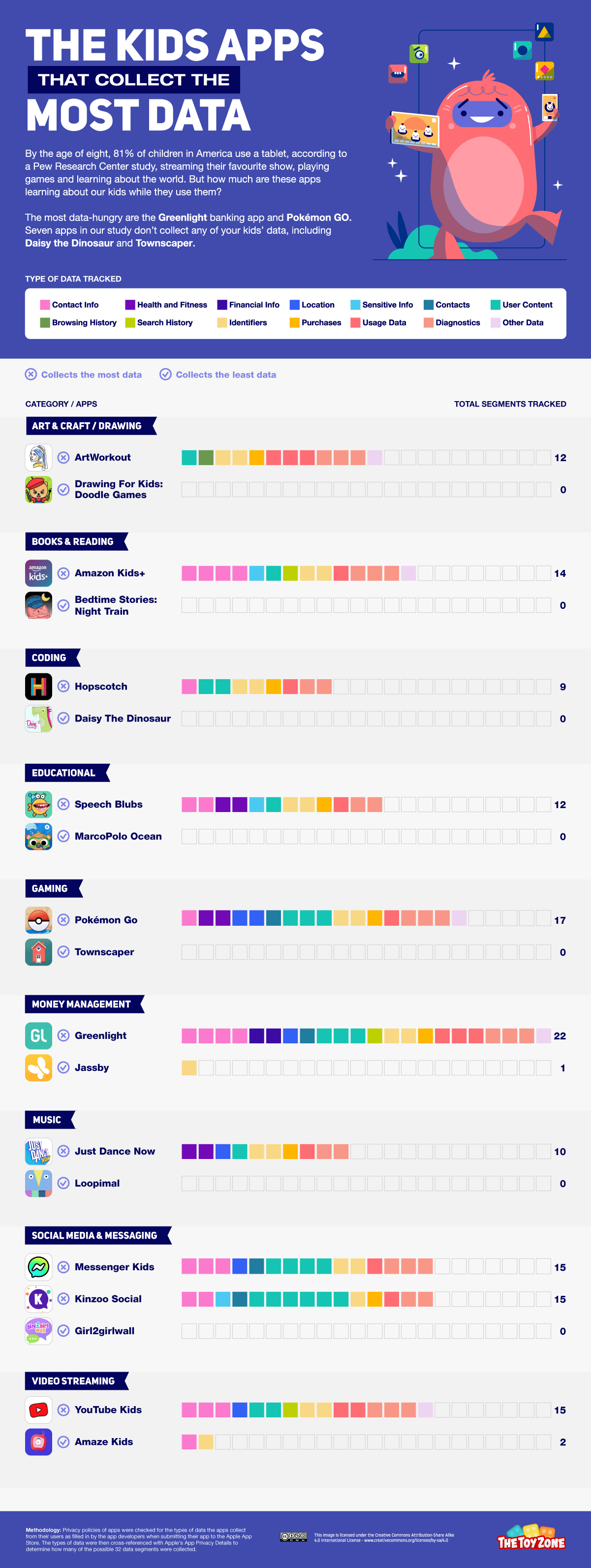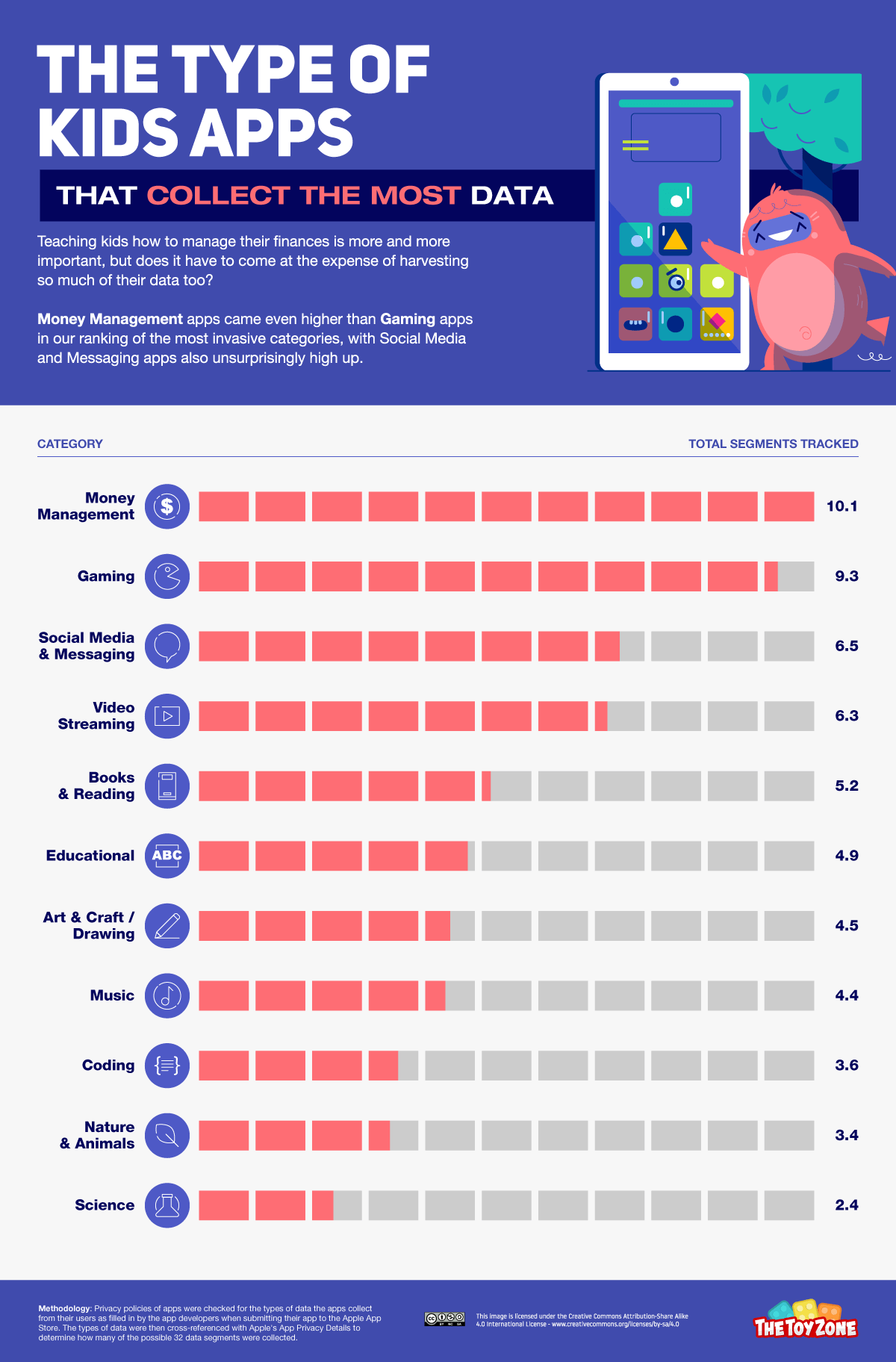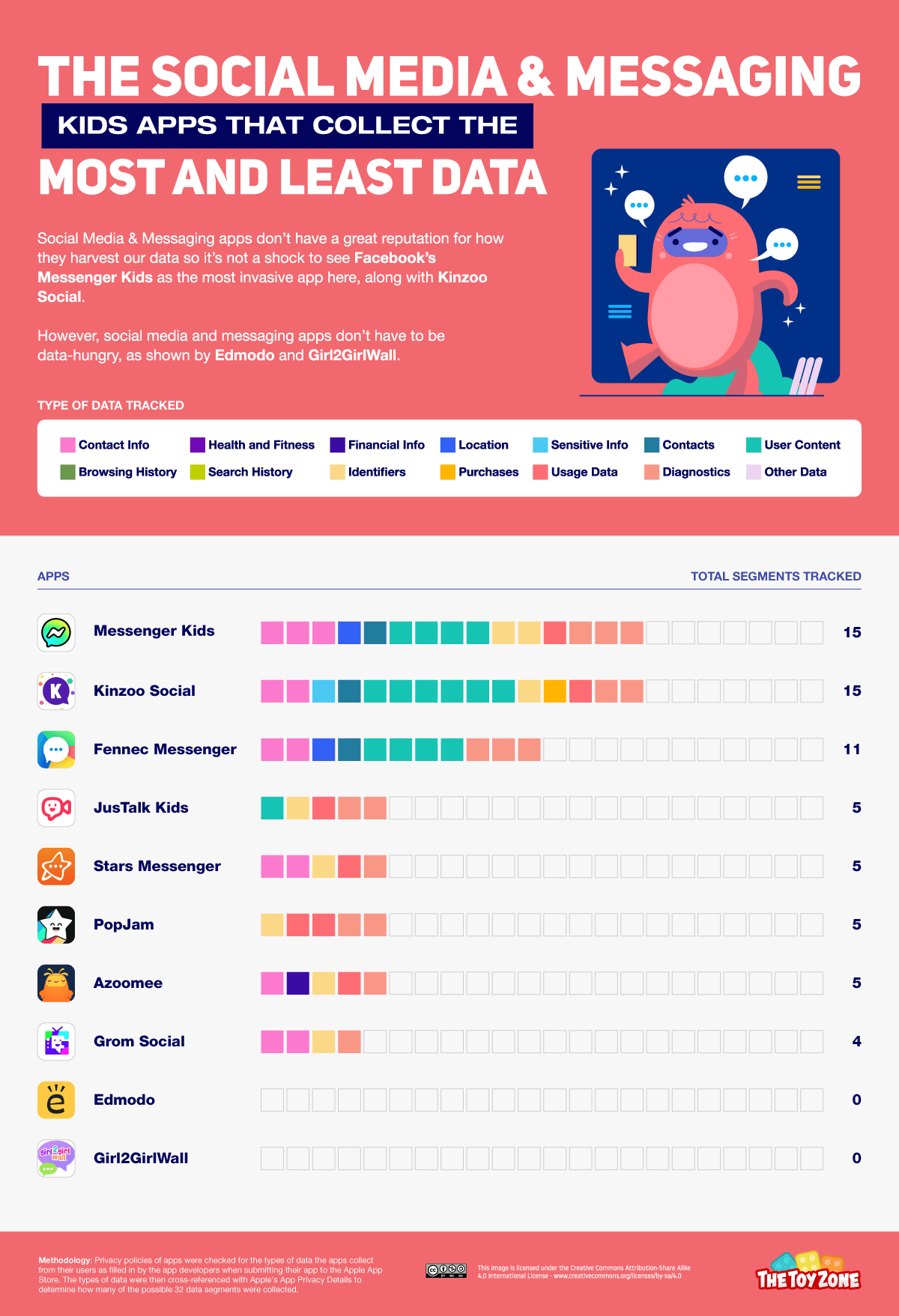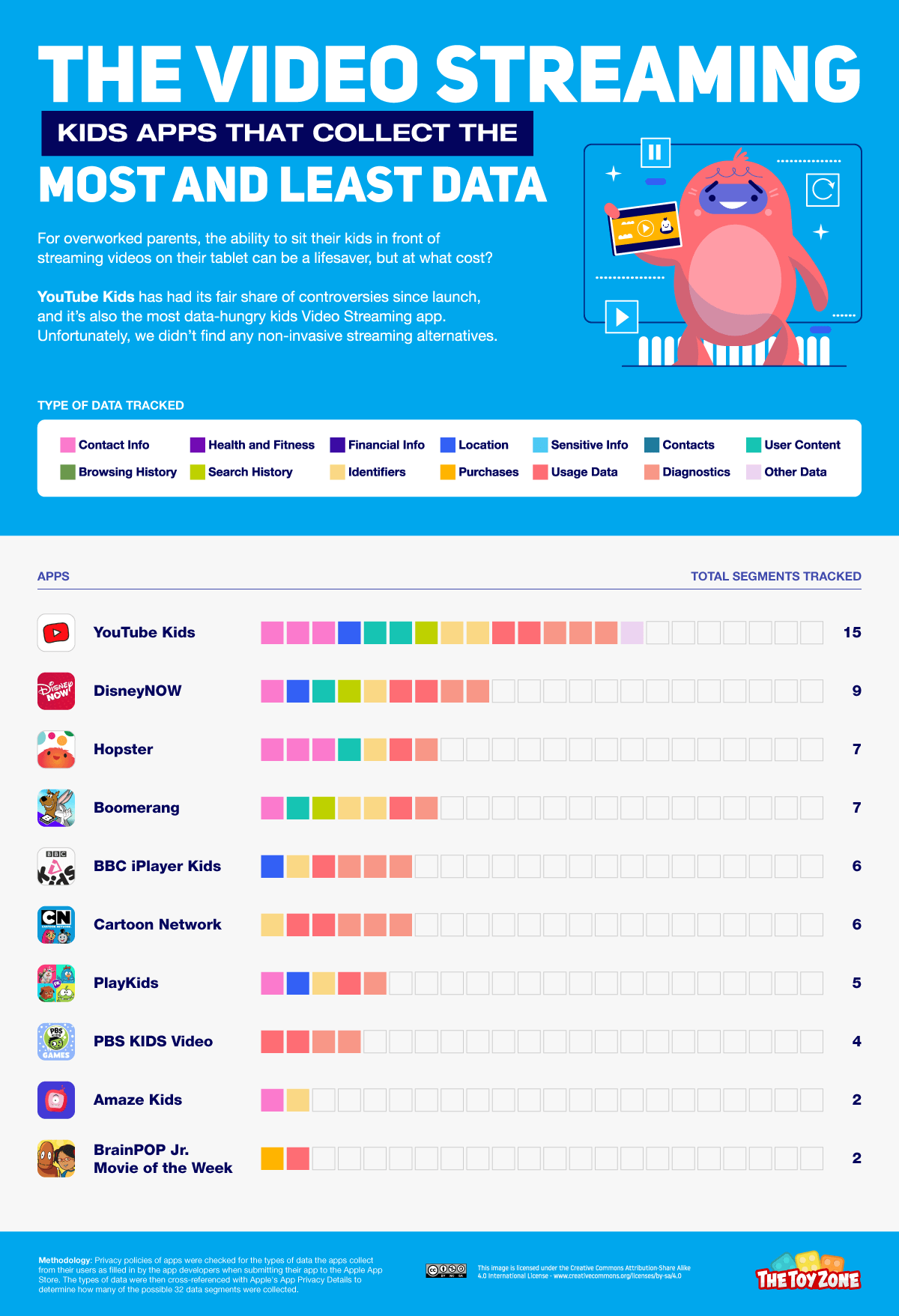In the good old days, of course, we only had television to rot the brain. When our folks warned us it would do so, the idea seemed either abstract or cool and gory, depending on how hard we were listening.
But today, one of the biggest dangers of children’s media remains abstract even to us parents. Yeah, it’s the data thing. When your kid picks up a device to play games or watch videos, even with your blessing, they hand valuable data to the game’s developers. One Berkeley study looked into thousands of children’s apps and found that:
“5% of the apps harvested location or contact data without verifiable parental consent, and nearly a fifth of the apps collected “personally identifiable information” [e.g. name, birthday, biometrics] through third-party software development kits (SDKs) that were not supposed to be used in child-directed apps. Many also transmitted data without adequate security.”
University of California, Berkeley
Still too abstract? Try: kids apps are tracking your kid’s online behavior and selling it as data to produce targeted ads (as well as raising other privacy and security issues).
As part of our quest to help parents narrow down their choices of toys and games, The ToyZone examined the most popular apps for kids to discover what kinds of app permissions each one needs – and which are the most invasive.
Key Findings
- The most invasive kid’s app in our study is Greenlight Kids & Teen Banking, tracking 22 types of data.
- Money Management apps for kids are the most data-hungry category, collecting an average of 10 data types each.
- Science apps are the least hungry on average, collecting around 2.4 data types.
- Of the 107 apps we surveyed, only 17 collected zero data.
It’s important to point out that most apps collect data legally, including data needed to make the software function. It’s also worth flagging that your kid may already understand more about ‘datafication’ than you.
Greenlight is the Most Personal-Data-Hungry Kid’s App
First, we counted how many data segments (categories of trackable info such as Financial Info, Browsing History) each app collects and ranked our findings. Greenlight Kids & Teen Banking collects 22 segments, including location information and three types of ‘usage data.’ This makes Greenlight the most invasive kid’s app in our study. The mobile games Pokémon GO (17 segments) and Animal Jam (16) are next in the ranking.
Greenlight claims not to sell or monetise user data. But it came under scrutiny in 2021 when Vice pointed out a loophole in its privacy agreement reserving Greenlight’s right to share personal information with ‘“ad and marketing vendors,” “insurance companies,” “collection agencies,” and the catch-all category of “other service providers.”’ The company has since removed this part of their policy, explaining it was there “in case we ever decide to offer merchant-funded offers to parents in the future based on aggregated and anonymous information.”
Which Type of Kid’s App Wants the Most Data?
Is there any particular type of app that’s more likely to gobble your kid’s data? Yes. Money Management apps (such as Greenlight) come out in front, requesting an average of 10.1 segment types across the eight apps in our study.
The World Health Organization has labelled gaming addiction as a mental health condition, so it’s worrying that gaming apps come second for data requests. By analysing your kid’s gaming habits and preferences, it could be straightforward to deliver precision-targeted ads for the next addiction. Games developer HyperBeard settled a $150,000 lawsuit alleging just that, having attempted to skirt the rules by labelling pre-teen oriented games as “not intended for children.”
Education: Speech Blubs is the Most Data-Hungry Learning App
Speech Blubs offers to “help your kid speak better, sooner, and more confidently.” Unfortunately, it is the most data-hungry app in its category, collecting 12 segments. These include two health & fitness segments and one “sensitive info” type – typically, sensitive info can be ethnic data, genetic info, biometrics, or similar.
In contrast, Easy Dyslexia Aid and MarcoPolo Ocean collect no personal data at all. The latter is a “digital sandbox” offering build-and-play activities to stir Junior’s interest in the sea and wider environmental issues.
Gaming: Pokémon GO is Out Hunting Data
Is that Pokémon GO app for you or your kid? Either way, you’ll want to be cautious while playing. It makes sense that the augmented reality (AR) hunting game requires your location to play. But by collecting 17 segments altogether, Pokémon GO becomes the most data-hungry app in gaming. And with the developer’s new AR bitcoin hunting game, things no longer look so innocent and fluffy.
Townscaper is a far less data-demanding game. The procedural town-building toy is painterly, satisfying, and yes – very addictive. But it asks no data of you. And the closest it comes to crypto is this fan project that uses Townscaper’s landscapes to visualise statistics such as the soaring value of bitcoin.
Social: Messenger Kids is Most Invasive Young Social App
The idea of their kids being on social media scares the heck out of most parents. And in the case of Facebook’s Messenger Kids and Kinzoo Social, the content is not the only worry – these apps collect up to 15 data segments each. By contrast, Girl2GirlWall is an anonymous, fully-moderated chat network that collects zero data segments.
Messenger Kids was devised as an alternative to messaging apps that made children vulnerable to predators. It features unique parental controls. But TechCrunch has pointed out that there’s “a lot of wiggle room there for extensive data collection on Facebook’s part” in the app’s privacy policy.
Video: YouTube Kids Sucks Most Data
Considering that video is a medium for consumption, it’s a surprise that we didn’t find any kid’s video apps that request zero data. YouTube Kids is the worst offender. It tracks 15 segments, including location, search history, and identifiers. YouTube paid $170m to settle allegations about collecting children’s personal data in 2019 but claims that its kid’s app uses data for recommendations rather than targeted advertising.
BrainPOP Jr. Movie of the Week is joint least hungry kid’s video app. It requires only purchase and usage data. The app delivers a new educational animation every week, follwed by retention and comprehension tests and keeping track of user scores. BrainPOP’s privacy policy declares that they “do not use student or children’s personal information for advertising purposes, including targeted advertising” and “do not rent or sell student data.”
Hungry, Hungry Apps
So, how can you protect kids from data-hungry apps? The first point is to stay vigilant – whatever steps you take are likely to become outdated or flawed as privacy policies change and digital culture evolves. It is of prime importance to maintain a healthy, open dialogue with children about both their personal privacy (what they say and do online) and their consumer privacy (the data they grant to software companies).
Together, you should also:
- Only download apps from reputable stores, particularly those with their own child protection policy (but beware these, too, can be flawed or circumvented).
- Apply strict privacy settings on new apps, browsers, and websites.
- Install parental controls if you feel comfortable using them.
- Emphasise that personal data is a valuable commodity like money or Pokémon cards.
For more information on every app we checked out, please explore our interactive table below.
Methodology
Privacy policies of children’s apps were checked for the types of data the apps collect from their users across “Data Used to Track You,” “Data Linked to You, and “Data Not Linked to You” as filled in by the app developers when submitting their app to the Apple App Store.
The types of data collected by each app were then cross-referenced with Apple’s App Privacy Details to determine how many of the possible 32 data segments (e.g. Contact Info, Location, Search History) each app collects from its users. Most and least invasive apps were determined based on the total count of segments tracked by each app. In cases where multiple apps were tied as least invasive, an app that was most similar to the most invasive app was listed as the least invasive (and best alternative).
The data was collected in January 2022.
Fair Use Statement
Whether you decide to share key findings from our study or the data visualizations themselves, please make sure to credit TheToyZone as the original source of the research by linking back to this page.











